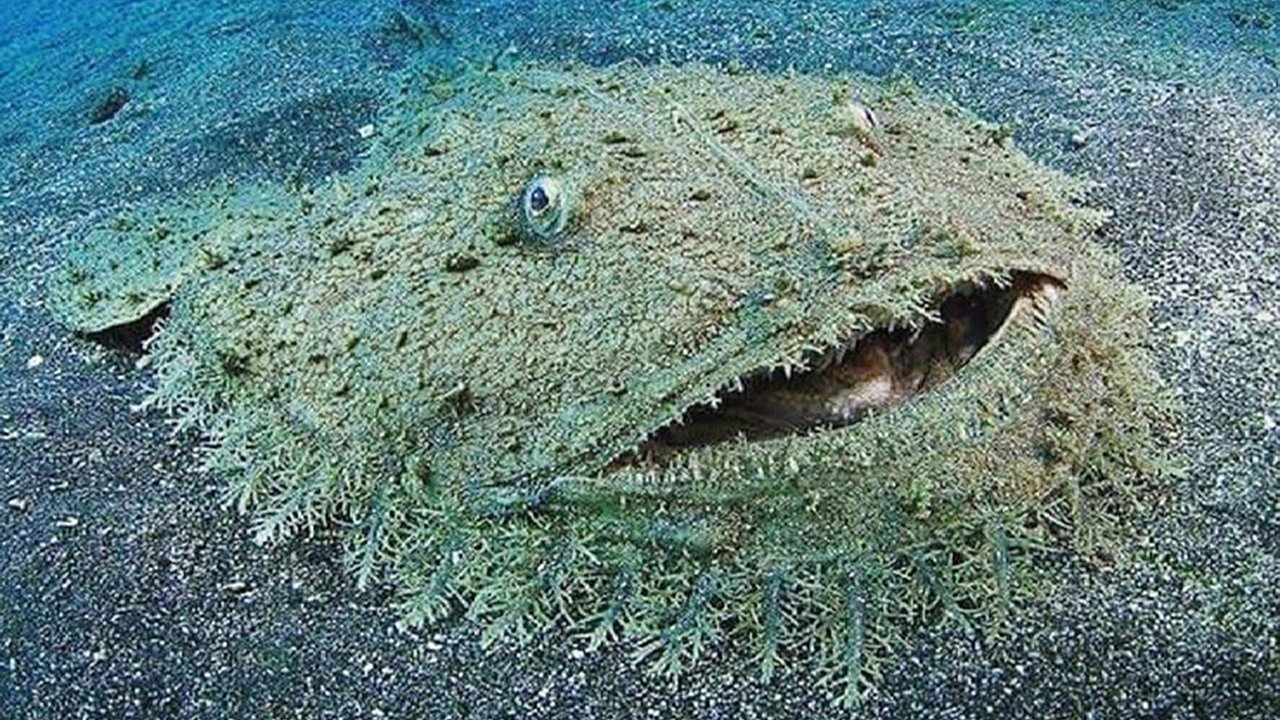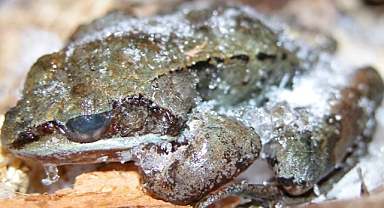With over 360 shark species populating the world, these fascinating creatures exhibit incredible diversity across their eight major groups. Among them, the Tasselled wobbegong shark stands out for its strikingly unusual appearance. Often nicknamed the "carpet shark," this species, known scientifically as Eucrossorhinus dasypogon, features a flattened body and intricate branching lobes around its head that help it blend seamlessly into its coral reef habitat.
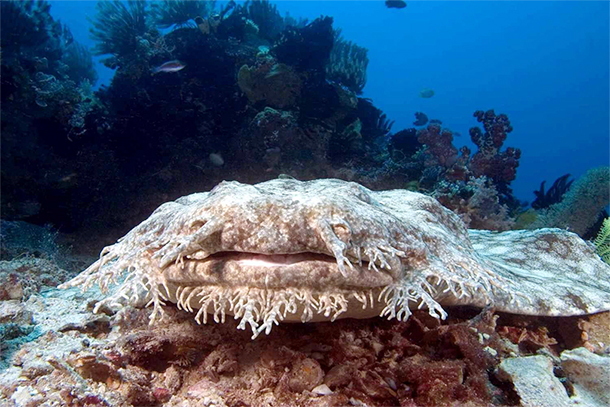 First described in 1867, the tasselled wobbegong remains somewhat of an enigma. Found in shallow coral reefs along the coasts of northern Australia, New Guinea, and nearby islands, this solitary predator spends its days resting in caves or under ledges. At night, it becomes an active and aggressive hunter, preying on fish and crustaceans—and sometimes even humans. Although attacks are rare, these sharks are known to bite unprovoked, with incidents often arising from accidental disturbances or mistaken identity.The tasselled wobbegong is the most specialized member of the wobbegong family, excelling in camouflage with its complex color patterns and branching dermal flaps. Though likely slower than similar species, its stealth and ambush tactics more than compensate for its lack of speed. This shark’s enormous mouth enables it to consume prey nearly as large as itself. For instance, one recorded wobbegong measuring 1.3 meters (4.3 feet) successfully swallowed a 1-meter (3.3-foot) brownbanded bamboo shark.
First described in 1867, the tasselled wobbegong remains somewhat of an enigma. Found in shallow coral reefs along the coasts of northern Australia, New Guinea, and nearby islands, this solitary predator spends its days resting in caves or under ledges. At night, it becomes an active and aggressive hunter, preying on fish and crustaceans—and sometimes even humans. Although attacks are rare, these sharks are known to bite unprovoked, with incidents often arising from accidental disturbances or mistaken identity.The tasselled wobbegong is the most specialized member of the wobbegong family, excelling in camouflage with its complex color patterns and branching dermal flaps. Though likely slower than similar species, its stealth and ambush tactics more than compensate for its lack of speed. This shark’s enormous mouth enables it to consume prey nearly as large as itself. For instance, one recorded wobbegong measuring 1.3 meters (4.3 feet) successfully swallowed a 1-meter (3.3-foot) brownbanded bamboo shark.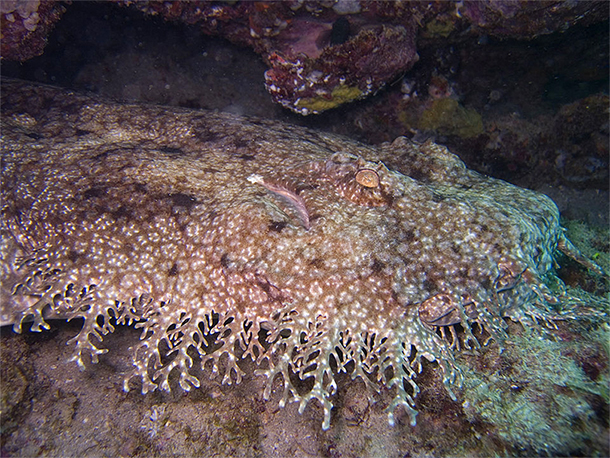 During the day, the tasselled wobbegong uses its ambush skills to capture unsuspecting fish, such as soldierfish and sweepers, which often share its resting spots. Observations suggest it engages in active baiting behavior, wagging its tail to mimic a small fish, complete with a black eyespot near the caudal fin. This clever tactic lures prey right into the shark’s jaws, making it a master of deception in its environment.Despite their fascinating behavior, wobbegongs have a reputation for unprovoked attacks on humans. The tasselled wobbegong, in particular, has been described as more aggressive than its relatives. Australian researcher Gilbert Whitley once claimed that these sharks "attack and generally kill the indigenous" of Papua New Guinea, though the accuracy of this statement remains uncertain. Nevertheless, caution is advised when encountering this species, as its poor vision and camouflaged appearance can lead to unintended confrontations.
During the day, the tasselled wobbegong uses its ambush skills to capture unsuspecting fish, such as soldierfish and sweepers, which often share its resting spots. Observations suggest it engages in active baiting behavior, wagging its tail to mimic a small fish, complete with a black eyespot near the caudal fin. This clever tactic lures prey right into the shark’s jaws, making it a master of deception in its environment.Despite their fascinating behavior, wobbegongs have a reputation for unprovoked attacks on humans. The tasselled wobbegong, in particular, has been described as more aggressive than its relatives. Australian researcher Gilbert Whitley once claimed that these sharks "attack and generally kill the indigenous" of Papua New Guinea, though the accuracy of this statement remains uncertain. Nevertheless, caution is advised when encountering this species, as its poor vision and camouflaged appearance can lead to unintended confrontations.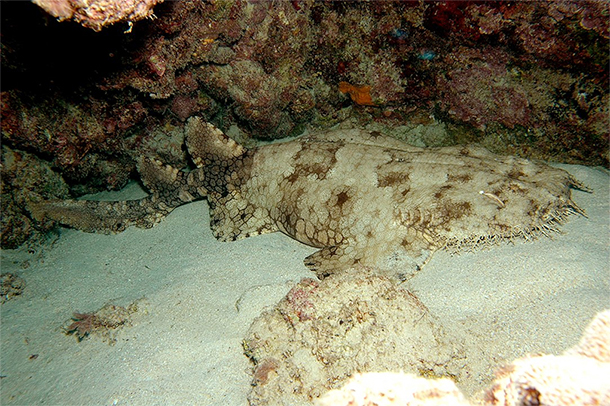 While the tasselled wobbegong attracts ecotourism enthusiasts and divers, its population faces threats from habitat loss, overfishing, and coral reef degradation caused by pollution and destructive practices like blast fishing. Conservation efforts are essential to ensure the survival of this unique and enigmatic species.
While the tasselled wobbegong attracts ecotourism enthusiasts and divers, its population faces threats from habitat loss, overfishing, and coral reef degradation caused by pollution and destructive practices like blast fishing. Conservation efforts are essential to ensure the survival of this unique and enigmatic species.
 First described in 1867, the tasselled wobbegong remains somewhat of an enigma. Found in shallow coral reefs along the coasts of northern Australia, New Guinea, and nearby islands, this solitary predator spends its days resting in caves or under ledges. At night, it becomes an active and aggressive hunter, preying on fish and crustaceans—and sometimes even humans. Although attacks are rare, these sharks are known to bite unprovoked, with incidents often arising from accidental disturbances or mistaken identity.The tasselled wobbegong is the most specialized member of the wobbegong family, excelling in camouflage with its complex color patterns and branching dermal flaps. Though likely slower than similar species, its stealth and ambush tactics more than compensate for its lack of speed. This shark’s enormous mouth enables it to consume prey nearly as large as itself. For instance, one recorded wobbegong measuring 1.3 meters (4.3 feet) successfully swallowed a 1-meter (3.3-foot) brownbanded bamboo shark.
First described in 1867, the tasselled wobbegong remains somewhat of an enigma. Found in shallow coral reefs along the coasts of northern Australia, New Guinea, and nearby islands, this solitary predator spends its days resting in caves or under ledges. At night, it becomes an active and aggressive hunter, preying on fish and crustaceans—and sometimes even humans. Although attacks are rare, these sharks are known to bite unprovoked, with incidents often arising from accidental disturbances or mistaken identity.The tasselled wobbegong is the most specialized member of the wobbegong family, excelling in camouflage with its complex color patterns and branching dermal flaps. Though likely slower than similar species, its stealth and ambush tactics more than compensate for its lack of speed. This shark’s enormous mouth enables it to consume prey nearly as large as itself. For instance, one recorded wobbegong measuring 1.3 meters (4.3 feet) successfully swallowed a 1-meter (3.3-foot) brownbanded bamboo shark. During the day, the tasselled wobbegong uses its ambush skills to capture unsuspecting fish, such as soldierfish and sweepers, which often share its resting spots. Observations suggest it engages in active baiting behavior, wagging its tail to mimic a small fish, complete with a black eyespot near the caudal fin. This clever tactic lures prey right into the shark’s jaws, making it a master of deception in its environment.Despite their fascinating behavior, wobbegongs have a reputation for unprovoked attacks on humans. The tasselled wobbegong, in particular, has been described as more aggressive than its relatives. Australian researcher Gilbert Whitley once claimed that these sharks "attack and generally kill the indigenous" of Papua New Guinea, though the accuracy of this statement remains uncertain. Nevertheless, caution is advised when encountering this species, as its poor vision and camouflaged appearance can lead to unintended confrontations.
During the day, the tasselled wobbegong uses its ambush skills to capture unsuspecting fish, such as soldierfish and sweepers, which often share its resting spots. Observations suggest it engages in active baiting behavior, wagging its tail to mimic a small fish, complete with a black eyespot near the caudal fin. This clever tactic lures prey right into the shark’s jaws, making it a master of deception in its environment.Despite their fascinating behavior, wobbegongs have a reputation for unprovoked attacks on humans. The tasselled wobbegong, in particular, has been described as more aggressive than its relatives. Australian researcher Gilbert Whitley once claimed that these sharks "attack and generally kill the indigenous" of Papua New Guinea, though the accuracy of this statement remains uncertain. Nevertheless, caution is advised when encountering this species, as its poor vision and camouflaged appearance can lead to unintended confrontations. While the tasselled wobbegong attracts ecotourism enthusiasts and divers, its population faces threats from habitat loss, overfishing, and coral reef degradation caused by pollution and destructive practices like blast fishing. Conservation efforts are essential to ensure the survival of this unique and enigmatic species.
While the tasselled wobbegong attracts ecotourism enthusiasts and divers, its population faces threats from habitat loss, overfishing, and coral reef degradation caused by pollution and destructive practices like blast fishing. Conservation efforts are essential to ensure the survival of this unique and enigmatic species.